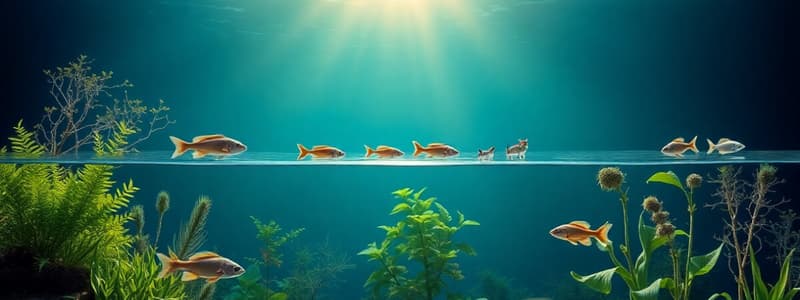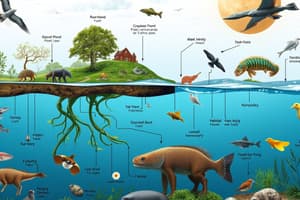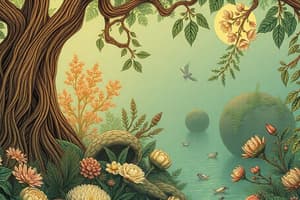Podcast
Questions and Answers
How would an ecosystem be affected if its producer population declined significantly?
How would an ecosystem be affected if its producer population declined significantly?
- The decomposer population would decrease due to a reduced supply of dead organic matter.
- The ecosystem would experience an increase in available energy at higher trophic levels.
- The consumer populations would decline due to less available energy. (correct)
- The consumer populations would increase due to lack of competition for resources.
In a food web, which trophic level directly consumes both producers and primary consumers?
In a food web, which trophic level directly consumes both producers and primary consumers?
- Primary Consumers
- Decomposers
- Tertiary Consumers
- Secondary Consumers (correct)
Which of the following correctly identifies the roles and energy sources of photoautotrophs and chemoautotrophs?
Which of the following correctly identifies the roles and energy sources of photoautotrophs and chemoautotrophs?
- Photoautotrophs and chemoautotrophs both use sunlight, but differ in the types of organic matter they produce.
- Photoautotrophs use chemical compounds, while chemoautotrophs use sunlight.
- Photoautotrophs use sunlight, while chemoautotrophs use chemical compounds. (correct)
- Photoautotrophs and chemoautotrophs both use chemical compounds, but differ in the ecosystems they inhabit.
What is the primary role of decomposers in an ecosystem's food web?
What is the primary role of decomposers in an ecosystem's food web?
If a new species of highly efficient predator, specializing in consuming secondary consumers, is introduced into an ecosystem, what is the most likely short-term impact on the ecosystem's trophic levels?
If a new species of highly efficient predator, specializing in consuming secondary consumers, is introduced into an ecosystem, what is the most likely short-term impact on the ecosystem's trophic levels?
In deep-sea hydrothermal vent ecosystems, which type of organism serves as the primary producer, and why?
In deep-sea hydrothermal vent ecosystems, which type of organism serves as the primary producer, and why?
How does eutrophication impact aquatic ecosystems, and what is the primary cause of this phenomenon?
How does eutrophication impact aquatic ecosystems, and what is the primary cause of this phenomenon?
Which of the following structural adaptations enables terrestrial plants to function as effective primary producers?
Which of the following structural adaptations enables terrestrial plants to function as effective primary producers?
How do diatoms contribute to both ecological and commercial processes?
How do diatoms contribute to both ecological and commercial processes?
What is the main difference in energy source utilization between photoautotrophs and chemoautotrophs?
What is the main difference in energy source utilization between photoautotrophs and chemoautotrophs?
Flashcards
Chemoautotrophs
Chemoautotrophs
Organisms that create glucose from inorganic chemicals using chemosynthesis.
What are Producers?
What are Producers?
Organisms that produce their own food through biochemical processes; also known as autotrophs.
What is a Food Web?
What is a Food Web?
Diagram showing the transfer of energy between different organisms in an ecosystem.
Chemosynthesis
Chemosynthesis
Signup and view all the flashcards
Producers
Producers
Signup and view all the flashcards
What are Trophic Levels?
What are Trophic Levels?
Signup and view all the flashcards
What are Consumers?
What are Consumers?
Signup and view all the flashcards
Terrestrial Producers
Terrestrial Producers
Signup and view all the flashcards
Aquatic Producers
Aquatic Producers
Signup and view all the flashcards
What are Photoautotrophs?
What are Photoautotrophs?
Signup and view all the flashcards
Study Notes
- Producers, also known as autotrophs, create their own food via biochemical processes.
- Producers are the foundation of the food web, supplying energy to all other organisms.
- The food web illustrates how energy transfers between species.
- Producers occupy the first trophic level.
Trophic Levels
- Trophic levels represent different layers in the food web; main levels include producers, primary, secondary, and tertiary consumers, and decomposers.
- Consumers obtain energy by eating other organisms, unlike producers.
- Primary consumers eat producers and are typically herbivores.
- Secondary consumers eat primary consumers and producers; they can be carnivores or omnivores.
- Tertiary consumers eat primary and secondary consumers, and sometimes producers; normally carnivores.
- Decomposers break down dead material and recycle nutrients.
Types of Producers
- Photoautotrophs use sunlight to create glucose through photosynthesis.
- Photoautotrophs, such as green plants, use chlorophyll to capture sunlight.
- The energy from sunlight is converted into ATP and NADPH to fix carbon dioxide into glucose.
- Chemoautotrophs use energy from inorganic chemicals to create glucose via chemosynthesis.
- Chemoautotrophs use molecules like hydrogen sulfide to fix carbon dioxide into glucose.
Photoautotrophs vs. Chemoautotrophs
- Energy source for photoautotrophs is sunlight, while chemoautotrophs use inorganic molecules.
- Photoautotrophs produce glucose and oxygen, while chemoautotrophs produce glucose, sulfur, and water.
- Green plants are examples of photoautotrophs, while deep-sea bacteria represent chemoautotrophs.
Examples of Producers
- Terrestrial producers, mainly plants with roots, stems, and leaves, include grasses, trees, and shrubs.
- Aquatic producers include algae, like kelp with holdfasts, and single-celled diatoms.
- Diatoms are used in manufacturing for products like silver polish and toothpaste.
- Seagrasses are true aquatic plants that act as photosynthetic producers.
- Chemoautotrophic bacteria are primary producers in deep-sea hydrothermal vents due to the absence of light.
- These bacteria use inorganic molecules from vents to create food, supporting complex ecosystems.
Importance of Producers
- Producers are the base of all energy transfers in the ecosystem.
- Insufficient producers can lead to ecosystems falling apart.
- Eutrophication, caused by nutrient pollution, leads to cyanobacteria overgrowth, disrupting ecosystems and creating dead zones.
Studying That Suits You
Use AI to generate personalized quizzes and flashcards to suit your learning preferences.




